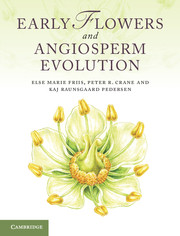Book contents
- Frontmatter
- Contents
- Preface
- 1 Introduction to angiosperms
- 2 The nature of the angiosperm fossil record
- 3 The environmental context of early angiosperm evolution
- 4 Stratigraphic framework and key areas for Cretaceous angiosperms
- 5 Angiosperms in context: extant and fossil seed plants
- 6 Origin and age of angiosperms
- 7 Phylogenetic framework and the assignment of fossils to extant groups
- 8 Fossils near the base of the angiosperm tree
- 9 Early fossil angiosperms of uncertain relationships
- 10 Early fossils of eumagnoliids
- 11 Fossils of monocots
- 12 Fossils of eudicots: early-diverging groups
- 13 Fossils of core eudicots: basal lineages
- 14 Fossils of core eudicots: rosids
- 15 Early fossils of eudicots: asterids
- 16 Patterns of structural diversification in angiosperm reproductive organs
- 17 History and evolution of pollination in angiosperms
- 18 History and evolution of dispersal in angiosperms
- 19 Vegetational context of early angiosperm diversification
- 20 The accumulation of angiosperm diversity
- References
- Index
Preface
Published online by Cambridge University Press: 07 September 2011
- Frontmatter
- Contents
- Preface
- 1 Introduction to angiosperms
- 2 The nature of the angiosperm fossil record
- 3 The environmental context of early angiosperm evolution
- 4 Stratigraphic framework and key areas for Cretaceous angiosperms
- 5 Angiosperms in context: extant and fossil seed plants
- 6 Origin and age of angiosperms
- 7 Phylogenetic framework and the assignment of fossils to extant groups
- 8 Fossils near the base of the angiosperm tree
- 9 Early fossil angiosperms of uncertain relationships
- 10 Early fossils of eumagnoliids
- 11 Fossils of monocots
- 12 Fossils of eudicots: early-diverging groups
- 13 Fossils of core eudicots: basal lineages
- 14 Fossils of core eudicots: rosids
- 15 Early fossils of eudicots: asterids
- 16 Patterns of structural diversification in angiosperm reproductive organs
- 17 History and evolution of pollination in angiosperms
- 18 History and evolution of dispersal in angiosperms
- 19 Vegetational context of early angiosperm diversification
- 20 The accumulation of angiosperm diversity
- References
- Index
Summary
Preface
Developments in the study of fossil and living plants over the past few decades have greatly clarified many aspects of early angiosperm evolution. Explicit phylogenetic analyses, facilitated by the development of computer technology and based on both morphological and molecular data, have renewed interest in the relationships of angiosperms to other plants, the patterns of relationship among major groups of angiosperms, and the processes that have generated angiosperm diversity at both microevolutionary and macroevolutionary scales. At the same time, a rapid accumulation of new information on the structure and biology of many key groups of living angiosperms has catalysed comparative studies and brought to light many previously unrecognised features that provide new perspectives on angiosperm evolution.
Palaeobotanical studies have also been central in revitalising research on early angiosperm evolution and have advanced significantly our understanding of early angiosperm history. In particular, the discovery of diverse and exquisitely preserved fossil flowers and floral organs from the Cretaceous has yielded detailed information on the structural and systematic diversity of early angiosperms. These data complement the information available from living plants, and are also invaluable for testing evolutionary hypotheses based on extant taxa against palaeobotanical and stratigraphic evidence. The recognition of fossil pollen grains in situ within flowers has also provided new possibilities for interpreting the record of dispersed fossil pollen. Only a few decades ago the abundant occurrence of fossil angiosperm flowers in Cretaceous strata was unimagined, but today there is a rich floral record, much of which still remains to be analysed in detail. The key breakthrough was the recognition that numerous small fossil flowers, which are generally not visible to collectors in the field, can be extracted from Cretaceous sediments by using bulk-sieving techniques and studied with scanning electron microscopy (SEM), and now also with synchrotron X-ray microtomography (SXRTM). These techniques, modified from standard approaches to Cenozoic fossil floras in Europe, and pioneered in the Late Cretaceous of Scania, Sweden, have now yielded diverse angiosperm flowers from many new fossil floras (mesofossil floras) discovered in Lower and Upper Cretaceous strata in Europe, North America, Asia, New Zealand and Antarctica.
- Type
- Chapter
- Information
- Early Flowers and Angiosperm Evolution , pp. ix - xPublisher: Cambridge University PressPrint publication year: 2011



